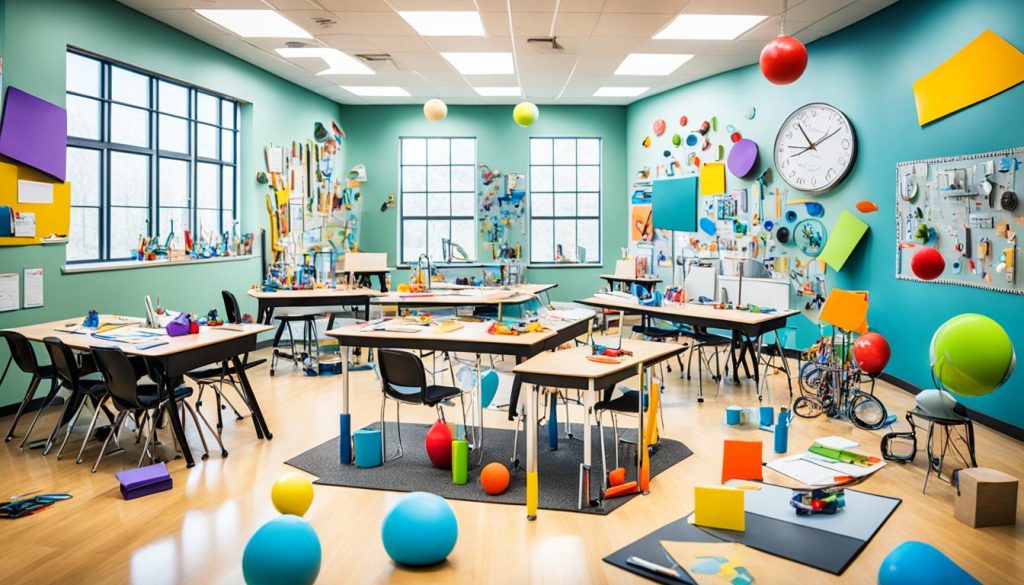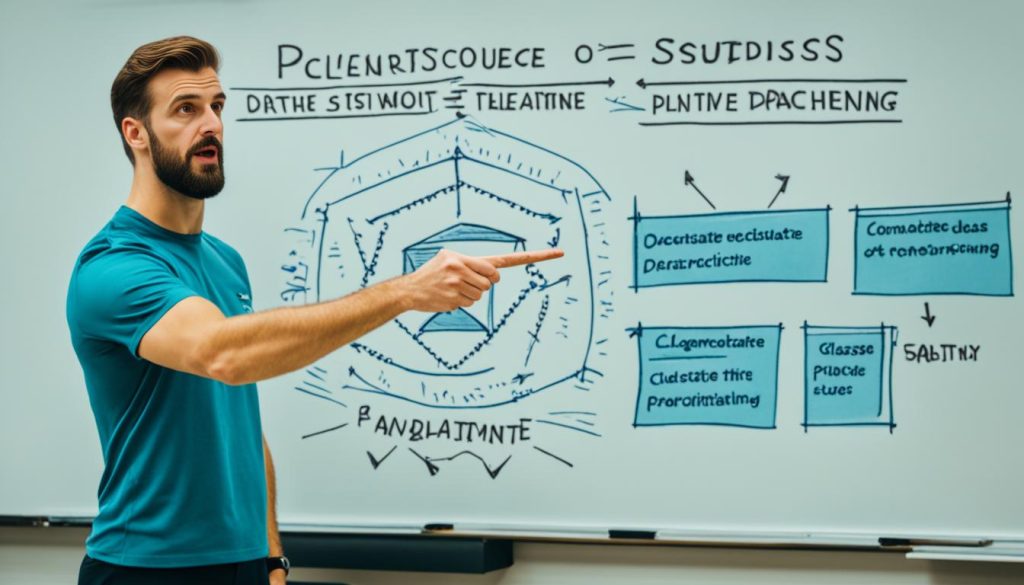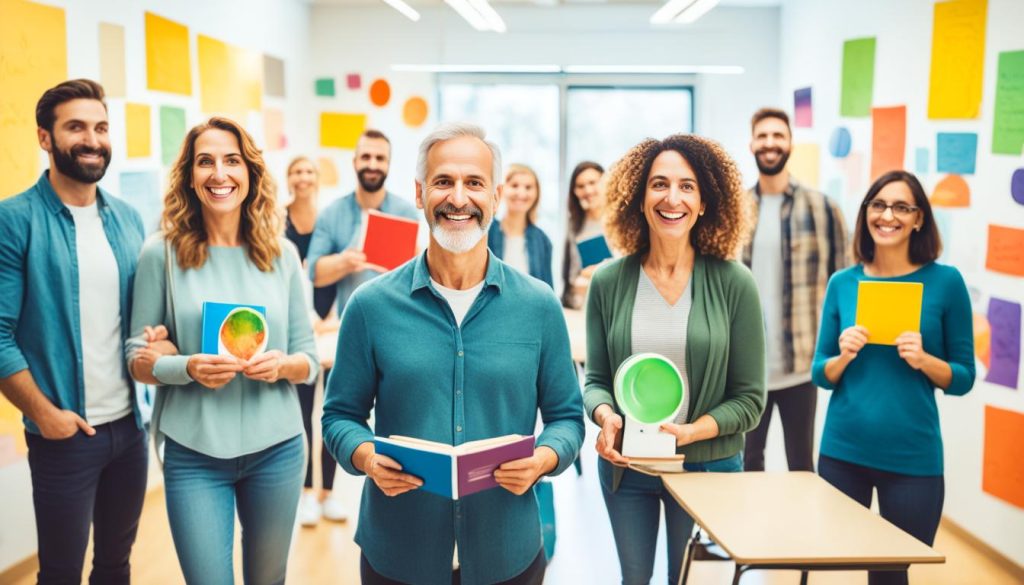Are you a teacher in the UK wanting to boost your skills and make learning fun? Do you aim to keep students interested and help them do better in school? This guide is packed with strategies made just for UK teachers. It will show you how to be a more effective and inspiring teacher.
Key Takeaways:
- Explore a variety of teaching strategies that are proven to enhance student engagement and improve learning outcomes.
- Understand the importance of continuous professional development to keep your teaching skills up-to-date.
- Discover the impact of a positive teacher-student relationship on the overall classroom experience.
- Learn effective assessment practices that promote student growth and understanding.
- Gain insights into the importance of vocabulary development for students’ academic success.
Importance of Effective Teaching Strategies
Effective teaching strategies are key to good learning outcomes and keeping students interested. Teachers who use a mix of proven strategies make learning fun and interactive. This way, students take an active part in their education.
Teachers need to keep learning to use the latest research and teaching methods. This means they can improve their teaching and meet their students’ changing needs.
It’s important to know how students learn best. Teachers should adjust their teaching to fit each student’s needs. This makes the classroom more welcoming and helps everyone learn better.
Student Engagement and Effective Teaching Strategies
When students are engaged, they’re more motivated and focused. Good teaching strategies keep them interested by adding fun activities and real-life examples to lessons.
Using technology, like online games or simulations, makes learning fun. These tools help students learn by doing and thinking critically.
Good teaching also means getting students to talk and work together. This helps them understand better and feel more confident in what they can do.
Getting students to engage is key to good teaching. It creates a positive classroom where everyone can succeed. By using different strategies, teachers can make learning more effective.
Next, we’ll look at teaching strategies that help teachers teach better and build strong relationships with students.
Understanding Different Teaching Strategies

Teaching strategies are key for effective educators. They help teachers support students by adjusting their methods. This depends on the topic, students’ expertise, and their learning stage.
Choosing the right teaching strategy is vital for teachers. They must consider their students’ needs and styles. This way, lessons can meet everyone’s strengths and challenges. It makes learning supportive and inclusive for all.
Multiple Strategies for Varied Learning Goals
Teachers often mix different teaching strategies in one lesson. This helps reach various learning goals. It makes sure all students, with their unique styles and abilities, understand the topic well.
For instance, a teacher might use hands-on learning for kinesthetic students. At the same time, they could use visual aids for visual learners. This mix makes learning fun and engaging for everyone.
Teachers should always improve their strategies based on feedback. Reflecting on what works helps them make better choices. This way, they can make learning more effective for students.
Using different teaching strategies helps create a supportive learning space. Students can grow and learn in many ways, like through hands-on activities or projects. Effective strategies make learning meaningful and connect with students at all levels.
Building Positive Teacher-Student Relationships
The teacher-student relationship is key in education. It’s more than just teaching; it’s about connecting, understanding, and helping students overcome learning hurdles. Creating strong bonds with students makes learning fun and supportive, boosting their motivation and growth.
Teachers who know their students well can tailor lessons to fit their needs. This makes learning more personal and effective.
Good teacher-student relationships lead to open talks, trust, and respect. Students feel valued and are more likely to join in, ask questions, and share their thoughts. This makes them feel part of the class and motivates them to learn more.
These relationships also help spot and fix learning blocks. Teachers build trust, making a safe space for students to talk about their problems. This lets teachers offer the right help and resources to help students move forward.
Studies show that strong teacher-student bonds boost students’ grades and happiness. Students do better when they feel connected to their teachers. They’re more engaged, motivated, and ready to learn. These relationships also help with social and emotional growth, leading to better school results.
Putting effort into building positive teacher-student relationships makes a school a place where everyone can do well. It’s about creating a caring connection based on empathy and support. This makes learning better, helps students get past learning blocks, and keeps them excited about learning and growing.
Effective Assessment Practices
Assessment is key in teaching and learning. It shows how well students understand and progress, helping teachers make better choices. Good assessment uses formative, summative, and diagnostic methods.
Formative assessment is ongoing. It gives teachers feedback on students’ learning right away. Teachers spot where students get things wrong, fill in gaps, and change their teaching to help everyone. With quizzes, observations, and discussions, teachers keep track of students’ progress and help them on time.
Summative assessment checks students’ learning at the end of a topic or course. It shows how much they know and can do. Exams, projects, and presentations not only test students but also give them feedback on how they’re doing.
Diagnostic assessment is vital for finding out what students don’t get. It helps teachers know what students already know and what they need to learn. With pre-tests and concept maps, teachers can see where students need help and plan better lessons.
Assessing students regularly helps track their progress. It shows patterns and trends, helps see how each student is doing, and guides teachers in making informed choices. These assessments also let students think about their learning and set goals for getting better.
<!–
Examples of Effective Assessment Strategies
- Quizzes and exit tickets
- Observations and checklists
- Peer assessments and self-assessments
- Portfolio assessments and projects
- Class discussions and debates
–>
Importance of Vocabulary Development
Students need strong communication skills to do well in school and later in their careers. Learning new words is a big part of this. It helps them share their thoughts and ideas clearly.
Teachers are key in helping students learn new words. They should explain specialist terms so students understand important ideas. By using new words in everyday lessons, students get to practice speaking and writing in a real way.
Working together to make vocabulary lists is a great idea. It makes learning more personal for students. By making these lists together, students feel more in charge of their learning. It also helps them understand terms specific to their subjects better.
Learning new words also helps students outside of school. They can share their thoughts and feelings more easily. This makes them more confident in all kinds of conversations, both in writing and talking.
In short, learning new words is a key part of education. Teachers help students by teaching them important terms and making learning active. This way, students get better at understanding complex ideas and talking about them. It boosts their communication skills across the board.
Explicit Instruction for Effective Learning

Explicit instruction is a top teaching method that uses clear explanations, lots of questions, and guided practice to boost learning. It focuses on the teacher leading the lesson to make sure students get the main ideas and skills.
Worked examples are key in this method. They show how to solve problems or finish tasks step by step. Teachers use these examples to help students learn how to tackle similar tasks. This way, students get to see the principles and strategies behind the tasks, which helps them learn better and remember more.
Another important part is asking structured questions. Good questions make students think deeply and get involved. Teachers use these questions to check if students understand, fix any wrong ideas, and help them learn better. The right questions make students think, analyze, and make their knowledge stronger.
Explicit instruction also focuses on guided practice. This lets students use what they’ve learned with the teacher’s help. It means students get feedback right away and know what they’re good at and what they need to work on. This helps students move from needing help to doing things on their own more easily.
For explicit instruction to work best, the classroom needs to be a great place to learn. Teachers should make sure there are no distractions and students can focus. In today’s world, online programs can make learning even better. These programs offer structured lessons, track progress, and have fun activities and multimedia, making learning with explicit instruction more effective.
Explicit instruction is great for learning because it uses clear explanations, examples, questions, and practice. Teachers using these methods can help students understand more deeply, remember better, and become better learners overall.
Effective Questioning Techniques
Effective questioning techniques are key to keeping students engaged and helping them think critically. By asking the right questions, teachers make the classroom a place where everyone takes part and understands deeply.
Open-ended questions are a great way to get students to think deeply and see things from different angles. These questions go beyond just yes or no answers. They let students share their thoughts and ideas. For instance, instead of asking, “Do you understand?”, a teacher might ask, “How do you interpret this concept?”.
Questions that make students explain their thinking help with metacognition. When students talk about their thought process, they notice their own thoughts better. This helps them understand the subject more. Teachers can ask, “Can you explain the steps you took to arrive at your answer?” or “What other approaches could you have taken to solve this problem?”.
Getting students to share their reasoning is crucial. By asking thought-provoking questions, teachers help students express their thoughts clearly. This promotes better communication and learning from each other.
Using effective questioning in class boosts critical thinking, problem-solving, and metacognition. By getting students to share their reasoning and explore different solutions, teachers create a lively learning space. This makes students more engaged and helps them understand and learn more.
Deliberate Practice for Skill Development

Deliberate practice is a top way to get better at skills and boost performance. It means breaking down hard skills into smaller parts and practicing each one by itself. Then, put these parts together for a full performance. This way, learners can get better at specific skills step by step.
By focusing on smaller skills, students can work on each part before moving on. This helps them understand the skill better and sets a strong base for learning more. It helps them see what they need to work on and focus on those areas to get really good.
Assessment is key in deliberate practice. Regular checks and tracking progress help teachers and students see how well each skill is mastered. This feedback lets them make changes quickly, keeping students on the right path and helping them overcome any problems.
Keeping skills sharp is just as crucial. Deliberate practice includes going back to skills learned before to make them stronger. By practicing these skills again, students keep them in their memory for longer. This makes sure they don’t forget what they’ve learned.
Deliberate practice is a strong way to improve skills, giving learners a clear plan to follow. It focuses on breaking skills into parts, checking progress, and keeping skills sharp. By using deliberate practice in schools, teachers can help students master their areas of interest and reach their highest potential.
The Impact of Learning Environment on Pedagogy
The learning environment is key to good teaching methods. A positive setting boosts active learning, keeps students involved, and offers tailored learning chances. This is especially true for online education, where setting up the right environment is vital.
In traditional classrooms, the layout, resources, and feel of the room shape the learning. But for online classes, teachers must adjust their approach to fit the needs of students learning from home.
Encouraging active learning is a big part of making a strong learning space. This means students don’t just sit and listen. They take part in the learning, think deeply, work together, and solve problems.
Getting students to engage is also key. When students are involved, they’re more motivated and ready to learn. Teachers can make this happen by using interactive tools, multimedia, and group work.
Personalized learning is crucial for adapting teaching to what each student needs. Teachers can adjust lessons and tasks to fit each student’s strengths, interests, and how they learn best. This makes learning more meaningful and boosts students’ grades.
Online classes offer new chances for personalized learning. Tools like learning platforms, adaptive tech, and data help teachers tailor lessons and give feedback. This makes online teaching more effective at meeting students’ varied needs.
In summary, the learning environment greatly shapes teaching methods. By focusing on active learning, keeping students engaged, and offering personalized learning, teachers can improve their teaching. For online classes, using the right tools and strategies is key. This helps create a lively and effective online classroom.
The Role of Pedagogy in Adult Education

Pedagogy is key in adult education, helping adults learn effectively. It focuses on building new skills and knowledge for their lives. It uses personalized learning plans and tackles the challenges adults face in getting an education.
Creating a supportive learning space is important. Adults often have work and family duties, making learning hard. But, a positive learning space can keep learners motivated and connected.
Personalized learning plans are vital. They recognize that adults have different backgrounds and ways of learning. This way, learning is tailored to each person’s needs and goals. It helps learners reach their full potential.
Access to education is also crucial. Many adults struggle with costs, time, or distance. Pedagogy aims to make learning easy to get. It uses technology and flexible schedules to help learners from all backgrounds.
Good teaching methods in adult education help learners grow. They gain new skills and improve their career chances. The aim is to make learning inclusive and supportive. It helps adults grow, learn for life, and succeed in a changing world.
Benefits of Pedagogy in Adult Education:
- Facilitates personalized learning plans tailored to individual needs and goals.
- Promotes access to education by overcoming barriers and providing flexible learning options.
- Fosters a supportive and engaging learning environment for adult learners.
- Encourages lifelong learning and continuous personal and professional development.
- Empowers adults to acquire competencies and skills relevant to their personal and professional lives.
Modern Pedagogical Approaches
Modern teaching methods focus on teamwork, flipped learning, and deep learning. These methods change classrooms by making students more active and understanding more deeply.
Collaborative learning makes students work together, improving their social and thinking skills. They take part in group talks, projects, and solving problems. This helps them think better and communicate well with others.
Flipped learning is another key method. Students learn outside class with videos or readings. Then, class time is for activities like debates, experiments, or talks. This way, students learn more deeply and actively.
Deep learning focuses on understanding subjects deeply and applying knowledge in real life. It teaches critical thinking, solving problems, and reflecting. This helps students grow intellectually and become independent learners.
Modern teaching combines proven methods with teacher expertise. It focuses on engaging students, critical thinking, and learning on their own. This leads to well-rounded individuals ready for the 21st century.
The Impact of Pedagogy on the Learning Process
Pedagogy is key to shaping the learning process and ensuring students do well. By using the right teaching methods, teachers can boost student achievement, critical thinking, and motivation.
Creating a supportive and engaging classroom is important. When students feel safe and valued, they take part more in their learning. This leads to a better understanding of the subject and helps develop critical thinking.
Teachers should consider each student’s unique needs. By adapting instruction to fit different learning styles and abilities, teachers make learning more engaging. This approach helps students stay interested and positive about learning.
Critical thinking is crucial and is developed through teaching methods. Teachers help students analyze, evaluate, and apply what they learn. This builds critical thinking skills, letting students think for themselves, make good decisions, and solve complex problems.
Motivation is essential for learning. Good teaching methods include ways to keep students motivated. This can be through making learning relevant, setting achievable goals, and giving helpful feedback. Motivated students are more likely to engage, overcome obstacles, and reach their goals.
In conclusion, pedagogy deeply affects how students learn. By using effective teaching methods, meeting student needs, promoting critical thinking, and keeping students motivated, teachers can make learning supportive and engaging. This approach helps students succeed and empowers them for the future.
Social Pedagogy and its Applications
Social pedagogy is a way of teaching that focuses on the whole growth of students. It puts empathy and kindness at the heart of education. This method aims to improve both their social and emotional skills and their grades.
This approach changes depending on the culture and society. But, it always aims to help people learn socially and develop personally. It moves beyond just teaching facts by focusing on how students interact with each other and their community.
In the classroom, social pedagogy makes learning a place where everyone feels included and supported. Teachers who use this method focus on understanding emotions and being kind. They help students get better at working with others and achieving their goals.
As education changes, social pedagogy shows us new ways to teach effectively. By using this approach, teachers can help students do well in school and grow into caring, confident people. These students will be ready to make a positive impact in the world.
















